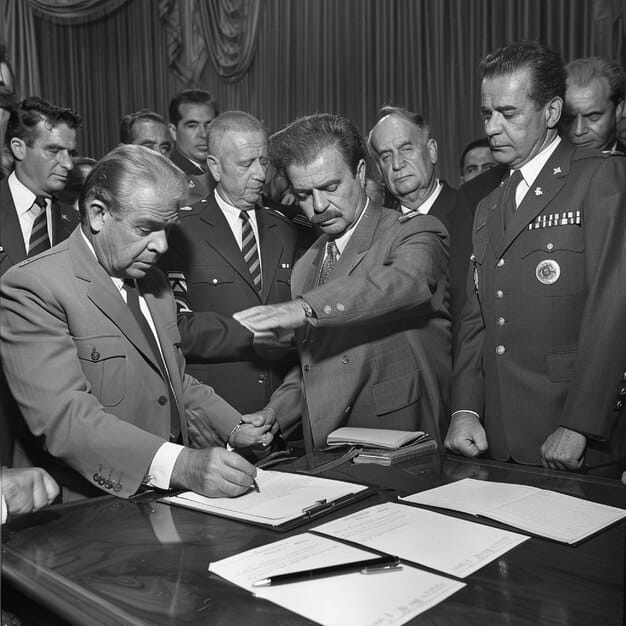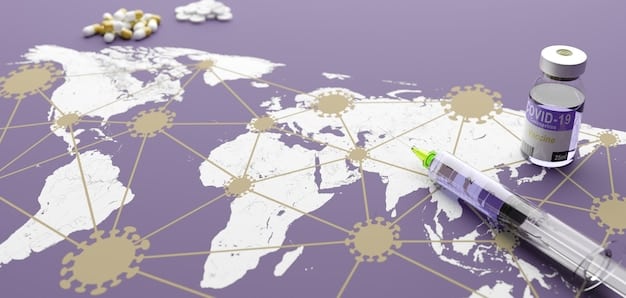The US and the WHO: Charting the Course for Future Global Health Collaboration

The US and the World Health Organization: A Look at Future Collaboration examines the intricate relationship between the United States and the WHO, exploring historical contexts, current challenges, and potential avenues for enhanced collaboration to address global health crises effectively.
The relationship between the US and the World Health Organization: A Look at Future Collaboration is multifaceted, marked by periods of close cooperation and times of tension. Understanding this dynamic is crucial for navigating the future of global health.
Understanding the Historical Context
To fully appreciate the current state of collaboration between the US and the WHO, it’s essential to delve into their shared history. This history is not just a series of events, but a narrative of evolving priorities, shifting geopolitical landscapes, and a continuous negotiation of power and influence.
Early Collaboration and US Influence
The United States played a significant role in the establishment of the WHO in 1948. From the outset, the US has been a major financial contributor and a key player in shaping the WHO’s agenda.
Periods of Alignment and Divergence
Over the decades, the US and the WHO have often found themselves aligned on key global health initiatives. However, there have also been periods of divergence, often related to policy differences or concerns about the WHO’s efficiency and effectiveness.

Key moments in the US-WHO relationship
- The US has historically been the largest single contributor to the WHO, providing significant funding for various health programs.
- During the Obama administration, the US strongly supported the WHO’s efforts to combat the Ebola outbreak in West Africa.
- The Trump administration’s decision to withdraw from the WHO in 2020 marked a significant departure from established norms of global health governance.
The historical context reveals a complex interplay of cooperation and contention, influenced by domestic politics and international health priorities. Understanding this history is crucial for shaping a more productive relationship in the future.
The Impact of US Funding on WHO Programs
The United States has historically been the largest single contributor to the WHO, and this funding has had a significant impact on the organization’s ability to implement various health programs worldwide. This impact is felt in areas ranging from disease eradication to health system strengthening.
Areas of US Funding Support
US funds have supported a wide range of WHO programs, including those focused on eradicating diseases such as polio and measles, improving maternal and child health, and strengthening health systems in developing countries.
Consequences of Funding Fluctuations
Changes in US funding levels have had a direct impact on the WHO’s ability to respond to global health challenges. When funding is reduced, programs may be scaled back or even discontinued, potentially undermining progress made in previous years.
Assessing the effectiveness of US funding
- US funding has contributed to significant progress in global health, including the eradication of smallpox and the reduction of polio cases worldwide.
- Some critics argue that US funding priorities can sometimes overshadow the needs of low- and middle-income countries.
- The WHO has been working to diversify its funding base to reduce its reliance on any single donor.

The impact of US funding on WHO programs is undeniable, but it also raises questions about the balance of power and the need for a more diversified and equitable funding model. A sustainable and predictable funding stream is essential for the WHO to effectively address global health challenges.
The COVID-19 Pandemic and Shifting Dynamics
The COVID-19 pandemic has brought the relationship between the US and the WHO into sharp focus, highlighting both the importance of international collaboration and the challenges of navigating differing national interests. The pandemic has served as a stress test for global health governance.
US Withdrawal and Re-engagement
The Trump administration’s decision to withdraw from the WHO in 2020, citing concerns about its handling of the pandemic, marked a significant disruption in the US-WHO relationship. The Biden administration reversed this decision upon taking office in 2021.
Lessons Learned from the Pandemic
The pandemic has underscored the need for greater international cooperation in responding to global health emergencies. It has also highlighted the importance of investing in pandemic preparedness and strengthening health systems worldwide.
Key challenges and opportunities
- The US and the WHO need to work together to improve global surveillance and early warning systems for emerging infectious diseases.
- There is a need for greater transparency and accountability in international health governance.
- The pandemic has created an opportunity to strengthen global health partnerships and build a more resilient global health system.
The COVID-19 pandemic has fundamentally altered the landscape of global health governance, creating both challenges and opportunities for the US and the WHO to work together more effectively in the future. A commitment to collaboration and a willingness to address past missteps are essential for moving forward.
Areas of Potential Collaboration
Despite the challenges and disagreements, there are several areas where the US and the WHO can potentially collaborate to advance global health. These collaborations can address critical global health issues and strengthen the global health architecture.
Pandemic Preparedness and Response
The US and the WHO can work together to strengthen global pandemic preparedness and response capabilities. This includes investing in research and development of vaccines and therapeutics, improving surveillance and early warning systems, and building surge capacity in healthcare systems.
Global Health Security
The US and the WHO can collaborate to address global health security threats, such as antimicrobial resistance and bioterrorism. This includes strengthening international regulations, promoting responsible use of antibiotics, and enhancing laboratory capacity.
Opportunities for collaboration
- The US and the WHO can work together to achieve universal health coverage, ensuring that everyone has access to essential health services without facing financial hardship.
- They can collaborate to address the social determinants of health, such as poverty, inequality, and lack of access to education and clean water.
- They can work together to promote healthy lifestyles and prevent noncommunicable diseases, such as heart disease, stroke, and diabetes.
By focusing on areas of mutual interest and shared goals, the US and the WHO can forge a stronger and more effective partnership for global health. This requires a commitment to open communication, mutual respect, and a willingness to compromise when necessary.
Challenges in the US-WHO Relationship
Despite the potential for collaboration, there are several challenges that could hinder the US-WHO relationship. These challenges range from political disagreements to funding constraints.
Political and Ideological Differences
Political and ideological differences between the US and other WHO member states can sometimes create friction and undermine collaboration. These differences can relate to issues such as reproductive health, intellectual property rights, and trade policy.
Funding and Resource Constraints
The WHO faces ongoing funding and resource constraints that can limit its ability to effectively address global health challenges. Dependence on a few large donors can create vulnerabilities and influence the organization’s priorities.
Overcoming these hurdles
- The US and the WHO need to find ways to bridge political and ideological divides and build consensus on key global health issues.
- The WHO needs to diversify its funding base and ensure that its resources are allocated efficiently and effectively.
- Both the US and the WHO need to be transparent and accountable in their actions and decision-making processes.
Addressing these challenges requires a commitment to open dialogue, mutual understanding, and a willingness to address difficult issues head-on. Overcoming these challenges is essential for building a stronger and more resilient global health system.
Future Directions and Recommendations
Looking ahead, there are several steps that the US and the WHO can take to strengthen their relationship and improve global health outcomes. These steps include building trust, enhancing transparency, and fostering collaboration.
Strengthening Trust and Communication
Building trust and open communication is essential for a productive US-WHO relationship. This includes regular consultations, transparent information sharing, and a willingness to listen to each other’s perspectives.
Enhancing Transparency and Accountability
Enhancing transparency and accountability in both the US and the WHO is crucial for building confidence and ensuring that resources are used effectively. This includes publicly disclosing data, participating in independent evaluations, and holding leaders accountable for their actions.
Recommendations for the future
- The US and the WHO should establish a regular high-level dialogue to discuss strategic priorities and address emerging challenges.
- They should work together to strengthen the WHO’s capacity to respond to global health emergencies.
- They should promote a more equitable and sustainable global health system that prioritizes the needs of low- and middle-income countries.
By taking these steps, the US and the WHO can chart a course for future collaboration that will benefit both countries and the world as a whole. A commitment to partnership and a shared vision for global health are essential for achieving this goal.
| Key Aspect | Brief Description |
|---|---|
| 🤝 Historical Ties | US played a key role in WHO’s formation. |
| 💰 Funding Impact | US funding significantly influences WHO programs. |
| 🌐 Pandemic Lessons | COVID-19 highlighted need for global coordination. |
| 🚀 Future Collab | Potential in pandemic preparedness and health security. |
Frequently Asked Questions
Collaboration with the WHO allows the US to leverage global expertise and resources in addressing health challenges that transcend national borders, such as pandemics and emerging diseases.
US funding significantly bolsters WHO’s capacity to execute global health programs, especially in areas like disease eradication, healthcare system enhancement, and emergency response initiatives.
Key challenges include political disagreements, funding fluctuations, and differing priorities, which can impede the effectiveness of their collaborative efforts in addressing global health issues.
The US and WHO can collaborate on pandemic preparedness, global health security, universal health coverage, and addressing the social determinants of health, leading to healthier populations globally.
The partnership can be strengthened by enhancing trust through open communication, increasing transparency, and establishing regular dialogues to address strategic priorities and emerging challenges in global health.
Conclusion
In conclusion, the US and the World Health Organization: A Look at Future Collaboration has a rich history marked by both cooperation and conflict. By focusing on shared goals, addressing challenges head-on, and building trust through open communication, the US and the WHO can forge a stronger and more effective partnership for global health, benefitting both countries and the world as a whole.





